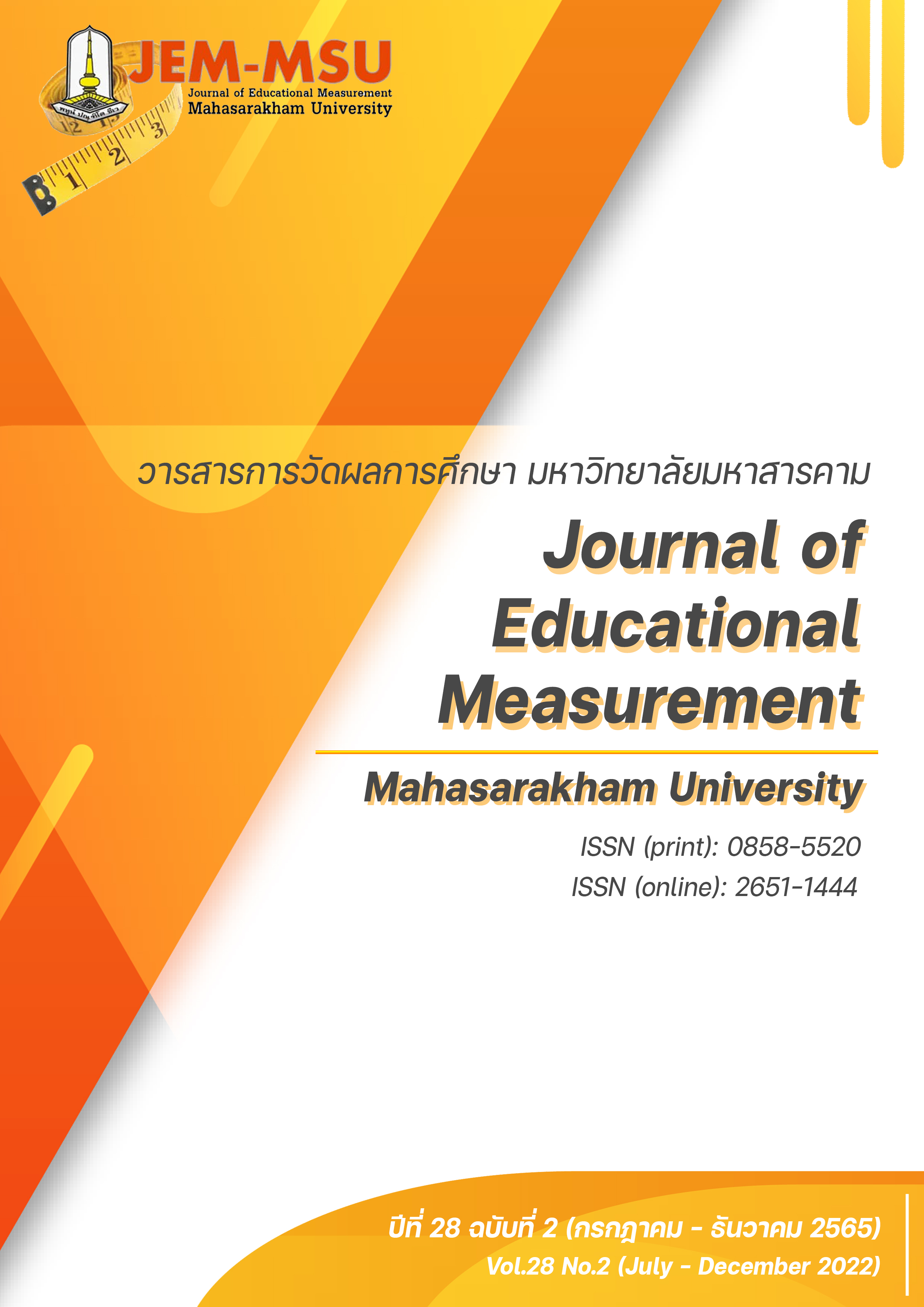โมเดลการวัดพหุระดับความเป็นพลเมืองดิจิทัลของนักเรียน ชั้นมัธยมศึกษาตอนต้น จังหวัดมุกดาหาร
Main Article Content
บทคัดย่อ
การวิจัยในครั้งนี้มีความมุ่งหมายเพื่อพัฒนาและตรวจสอบความตรงของโมเดลการวัดพหุระดับ ความเป็นพลเมืองดิจิทัลของนักเรียนชั้นมัธยมศึกษาตอนต้น จังหวัดมุกดาหาร ทั้งในระดับนักเรียนและระดับห้องเรียน ตัวอย่างคือ นักเรียนชั้นมัธยมศึกษาตอนต้น ปีการศึกษา 2563 จังหวัดมุกดาหาร จำนวน 1,632 คน จำนวน 10 โรง จาก 110 ห้อง ได้มาโดยการสุ่มแบบหลายขั้นตอน (multi - stage random sampling) เครื่องมือที่ใช้คือ แบบวัดความเป็นพลเมืองดิจิทัล จำนวน 1 ฉบับ รวม 48 ข้อ มีค่าอำนาจจำแนกตั้งแต่ 0.22 ถึง 0.61 ค่าความเชื่อมั่น 0.91 วิเคราะห์ข้อมูลโดยใช้สถิติพื้นฐาน วิเคราะห์สัมประสิทธิ์สหสัมพันธ์ (Pearson’s product moment) วิเคราะห์องค์ประกอบเชิงยืนยันพหุระดับ (Multi-Level Confirmatory Factors Analysis : MCFA) ผลการวิจัยพบว่า
การพัฒนาโมเดลการวัดพหุระดับความเป็นพลเมืองดิจิทัลของนักเรียนชั้นมัธยมศึกษาตอนต้นในระดับนักเรียนและระดับห้องเรียนประกอบด้วยตัวแปรสังเกตได้ 8 ตัวแปร ได้แก่ การรักษาอัตลักษณ์ที่ดีของตนเอง การจัดสรรเวลาหน้าจอ การจัดการการคุกคามบนโลกออนไลน์ การจัดการความปลอดภัยของตนเองในโลกออนไลน์ การจัดการข้อมูลส่วนตัว การรู้เท่าทันสื่อและสารสนเทศ การจัดการข้อมูลที่เป็นร่องรอยบนโลกออนไลน์ และการใช้เทคโนโลยีอย่างมีจริยธรรม โดยโมเดลการวัดพหุระดับความเป็นพลเมืองดิจิทัลมีความตรง
เชิงโครงสร้างหรือมีความสอดคล้องกลมกลืนกับข้อมูลเชิงประจักษ์โดยพิจารณาจากค่าดัชนีที่ใช้ตรวจสอบความตรงของโมเดล ได้แก่ ค่า = 36.69, df = 26, p = 0.08, RMSEA = 0.02, SRMRw = 0.01, SRMRb = 0.03, CFI = 0.99, TLI = 0.99 และ
/df = 1.41 และตัวแปรสังเกตได้มีค่าสหสัมพันธ์ภายในชั้น (ICC) อยู่ระหว่าง 0.06 - 0.21 โดยในระดับนักเรียนตัวแปรที่มีน้ำหนักความสำคัญ (
) สูงสุดคือ การรู้เท่าทันสื่อและสารสนเทศ (
= 0.92) รองลงมาได้แก่ การใช้เทคโนโลยีอย่างมีจริยธรรม และการจัดการข้อมูลส่วนตัว (
= 0.85) มีค่าเท่ากัน ส่วนตัวแปรที่มีน้ำหนักความสำคัญต่ำสุดคือ การรักษาอัตลักษณ์ที่ดีของตนเอง (
= 0.64) ในระดับห้องเรียน ตัวแปรที่มีน้ำหนักความสำคัญสูงสุดคือ การจัดการข้อมูลที่เป็นร่องรอยบนโลกออนไลน์ (
= 0.98) รองลงมาได้แก่ การรู้เท่าทันสื่อและสารสนเทศ (
= 0.95) และการรักษาอัตลักษณ์ที่ดีของตนเอง มีน้ำหนักความสำคัญต่ำสุด (
= 0.82)
Article Details

This work is licensed under a Creative Commons Attribution-NonCommercial-NoDerivatives 4.0 International License.
เนื้อหาและข้อมูลในบทความที่ลงตีพิมพ์ในวารสารการวัดผลการศึกษา มหาวิทยาลัยมหาสารคาม ถือเป็นข้อคิดเห็นและความรับผิดชอบของผู้เขียนบทความโดยตรง ซึ่งกองบรรณาธิการวารสาร ไม่จำเป็นต้องเห็นด้วย หรือร่วมรับผิดชอบใดๆ
บทความ ข้อมูล เนื้อหา รูปภาพ ฯลฯ ที่ได้รับการตีพิมพ์ในวารสารการวัดผลการศึกษา มหาวิทยาลัยมหาสารคาม ถือเป็นลิขสิทธิ์ของวารสารการวัดผลการศึกษา มหาวิทยาลัยมหาสารคาม หากบุคคลหรือหน่วยงานใดต้องการนำทั้งหมดหรือส่วนใดส่วนหนึ่งไปเผยแพร่ต่อหรือกระทำการใดๆ จะต้องได้รับอนุญาตเป็นลายลักษณ์อักษรจากวารสารการวัดผลการศึกษา มหาวิทยาลัยมหาสารคาม ก่อนเท่านั้น
References
Diamantopoulos, A. & Siguaw, J. A., (2000). Introduction to LISREL: A guide for the uninitiated. SAGE Publications, Inc.
DQ Institute. (2019). Digital intelligence (DQ): DQ Global Standards Report 2019 Common Framework for Digital Literacy, Skills and Readiness. http://www.dqinstitute.org/wp-content/uploads/2019/11/DQGlobalStandardsReport2019.pdf
Fan, X. & Sivo, S. (2005). Sensitivity of fit indexes to misspecified structural or measurement model components: Rationale of two-index strategy revisited. Structural Equation Modeling, 12(3), 343-367.
Muthen, B. O. (1989). Latent variable modeling in heterogeneous populations. Psychometrika, 54(4), 557-585.
Park, Y. (2019). IQ, EQ, and DQ. https://www.dqinstitute.org/wp-content/uploads/2019/11/DQGlobalStandardsReport2019.pdf
Snijders, T. A. B., & Bosker, R. J. (1999). Multilevel analysis: An introduction to basic and advanced multilevel modeling. Thousand Oaks: Sage Publications.
Angsuchoti, S., Wijitwanna, S. & Pinyopanuwat, R. (2009). Analytical statistics for research Learning Theory and Learning Behavior, Lisrel Programming Techniques (3th ed.). CDMKprinting. (in Thai)
Biggins, O. (2012). Media and Information Literacy. Journal of SUDDHIPARITAD Review, 26(80),147-161. (in Thai)
Center for the Promotion and Protection of Children and Youths in the Use of Online Media. (2019). Report on the situation of Thai children and online dangers 2019 on August 19, 2019 at the Department of Children and Youth Affairs. Ministry of Social Development and Human Security. https://inetfoundation.or.th/ Welcome/activity?id=59 (in Thai)
Chadcham, S. & Kornpetpanee, S. (2004). Structural Equation Modeling. Journal of educational researcch and measurement, 1(1), 1-24.
Child Media. (2020). DQ Digital Intelligence (3th ed.). Child Media. http://cclickthailand.com/ wpcontent/uploads/2020/04/dq_FINAL.pdf?fbclid=IwAR3sPj6MS_MMn1Qv13h314GSUDF5z3Oq9KfC397jpGATe98HAvjmQ30BMo (in Thai)
Kaiyawan, Y. (2013). Multivariate statistical analysis for research. Chulalongkorn University Press. (in Thai)
Kanjanawasee, S. (2011). Classical Test Theory (5th ed.). Chulalongkorn University Press. (in Thai)
Phornprasert, W. (2019). The development of students digital citizenship scale and norms in higher education institutions (Phitsanulok) [Doctor’s thesis]. Naresuan University. (in Thai)
Sarnnok, K. & Wannapiroon, P. (2018). Applying Internet of Everything Technology to Create a Ubiquitous Learning Environment for Digital Native. Journal Of Association of Private Higher Education Institutions of Thailand under the Patronage of Her Royal Highness Princess Maha Chakri Sirindhorn, 7(1), 124. (in Thai)
Thumbsup. (2016). Know the new indicators “DQ” Digital genius with 8 skills that children must be used wisely. http://thumbsup.in.th/ 2016/10/how-digital-intelligence-important-for-all-children/ (in Thai)

